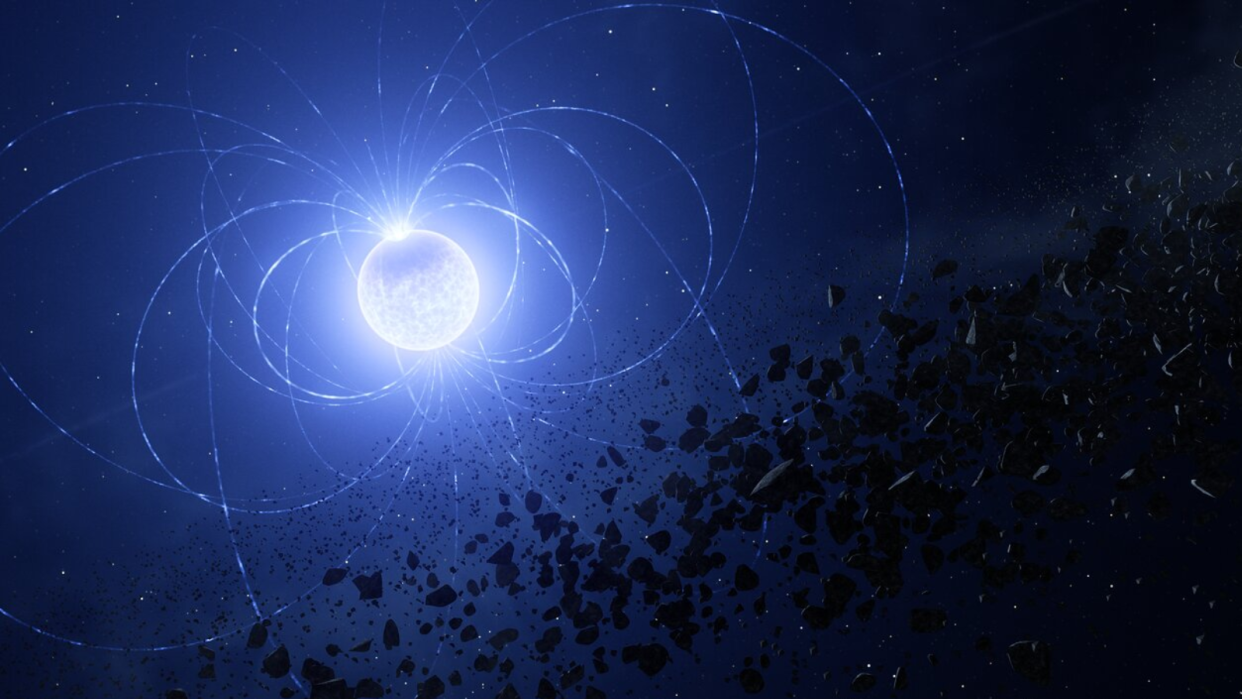Zombie star earns metal scar while chewing its own planets: 'Nothing like this has been seen before'

A dead star devouring its own planets like a rampaging cosmic zombie has been scarred by planetary debris.
The imprinted metal scar sits on the surface of this white dwarf star; this type of stellar remnant will be left over when the sun dies as well, and shows there is "life after death" for planetary systems.
The scar on the surface of the white dwarf, dubbed WD 0816-310, was spotted by a team of astronomers using the Very Large Telescope (VLT) located in the Atacama desert region of Northern Chile. It represents the first unique signature seen on a white dwarf star due to the cannibalization of planets and asteroids.
"It is well known that some white dwarfs — slowly cooling embers of stars like our sun — are cannibalizing pieces of their planetary systems," team leader and Armagh Observatory astronomer Stefano Bagnulo said in a statement. "Now we have discovered that the star's magnetic field plays a key role in this process, resulting in a scar on the white dwarf’s surface."
Related: These supernovas are whipping up a storm, contributing to cosmic life and death
The team of astronomers was able to use the VLT to discover the origins of the metal scar worn by WD 0816-310, which around the size of Earth with a mass around that of the sun.
"We have demonstrated that these metals originate from a planetary fragment as large as or possibly larger than Vesta, which is about 500 kilometers (311 miles) across and the second-largest asteroid in the solar system," Jay Farihi, discovery team member and University College London professor, said in the statement.
A dead star and its metal scar
White dwarfs are born when stars around the size of the sun exhaust the fuel supply necessary for nuclear fusion happening in their cores. As this process ends, so does the outward-flowing energy that has supported each star against the inward push of its own gravity for billions of years.
This results in the core of the star collapsing while its outer layers, where nuclear fusion proceeds, "puff out" to tens, or hundreds, of times the original width of the dying star. This is known as the red giant phase of the star's life, and it is a phase the sun will experience in around 5 billion years. When it becomes a red giant, the sun will swell out to around the orbit of Mars and swallow the inner planets, including Earth.
The red giant phase is short-lived, with the star's outer layers continuing to disperse and cool. This eventually leaves behind a planetary nebula of gas and dust. This nebula would be made from stellar material once surrounding a smoldering stellar core that has turned into a cosmic ember: A white dwarf.
These white dwarfs can then go on to accrete the remaining bodies in their systems, like planets and asteroids, that weren't destroyed during the red giant phase.
Astronomers have previously observed white dwarfs polluted by metals from bodies they have accreted. The idea is that such pollution occurs when the bodies eer too close to these dead stars.
The team's new observation is different, however, because material accreted to WD 0816-310 seems to have been concentrated in only one region, resembling a scar.
The strength of the signal from metals on WD 0816-310 seems to change as the dead star rotates. This indicates the metals are concentrated in a specific area rather than being dispersed evenly across the star's surface. Further, the observed changes are synchronized with changes in the magnetic field of WD 0816-310, which suggests its metal scar is located at one of its poles.
"Surprisingly, the material was not evenly mixed over the surface of the star, as predicted by theory. Instead, this scar is a concentrated patch of planetary material, held in place by the same magnetic field that has guided the infalling fragments," team member and Western University professor John Landstreet said in the statement. "Nothing like this has been seen before."
RELATED STORIES:
— Right before exploding, this star puffed out a sun's worth of mass
— Supernova explosion's weird leftovers may contain a super-dense star
— Supernova explosion's weird leftovers may contain a super-dense star
To reach these conclusions, the team made use of a VLT instrument called the Focal Reducer and low dispersion Spectrograph (FORS2). FORS2 is described as "the Swiss Army knife" of the instruments at the Paranal Observatory because of its capability to study many different astronomical objects in many different ways.
FORS2 was sensitive enough to allow the team to observe this faint white dwarf and measure its magnetic field. That's what led to the clues that the star has a scar.
In addition to showing how planetary systems remain active dynamically after death, the results demonstrate the power of FORS2 to examine things like the bulk composition of planets orbiting other stars outside the solar system.
The team's research was published on Feb. 26 in the Astrophysical Journal Letters
